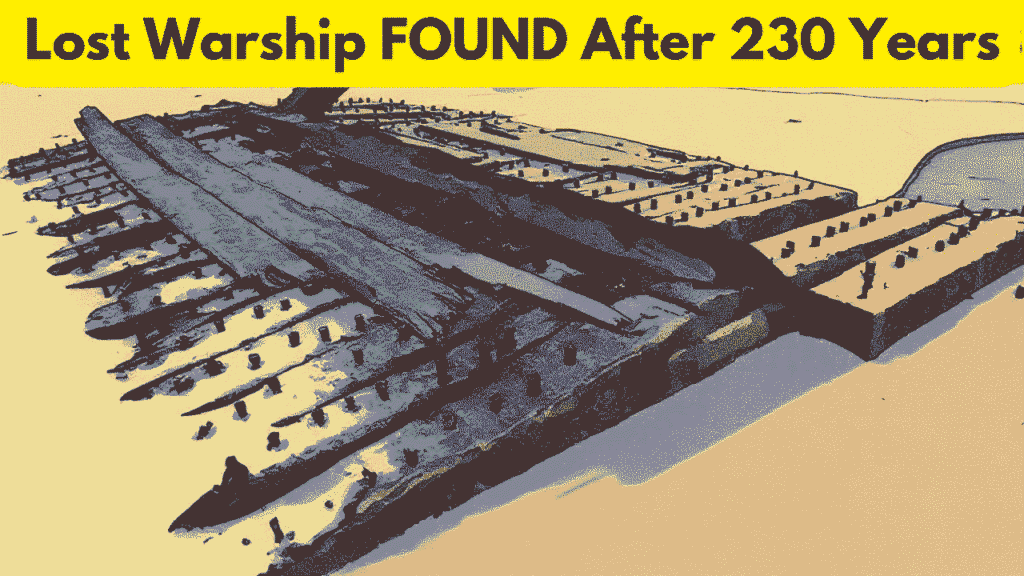A lost British warship discovered after more than two centuries has reignited historical curiosity along the windswept coast of Orkney, Scotland. Unearthed by shifting sands and tidal erosion, the remains are believed to belong to a 230-year-old military vessel, likely HMS Lossie, a long-lost Royal Navy ship that mysteriously vanished in the late 18th century.
The wreckage, partially embedded beneath layers of sand and peat, emerged near Sanday, one of Orkney’s northern isles, following recent storm surges and rising tides. Experts from Historic Environment Scotland (HES) and local archaeologists quickly mobilized to investigate, identifying wooden hull fragments, iron fittings, and decaying ship ribs.
Table of Contents
📣 Reactions from Experts and the Public
Dr. Kirsty Owen, a marine archaeologist with HES, described the find as “an extraordinary window into Britain’s naval past.” She added, “If confirmed, this would be one of the most significant warship discoveries in the region in decades.”
Local residents, long aware of rumors of an old wreck under the dunes, were awestruck by the scale and detail now revealed. Social media buzzed with photos and drone footage, sparking debate among historians and maritime enthusiasts alike.
Some believe the ship could have been involved in Napoleonic-era coastal patrols, while others suspect it may have run aground during a violent storm while escorting merchant convoys around the North Sea.
⚓ Why This Discovery Matters: Strategic and Historic Significance
This lost British warship discovery is more than just a curiosity—it offers rare insight into Royal Navy engineering, 18th-century naval warfare, and Britain’s maritime dominance during a globally turbulent period.
The Orkney archipelago played a pivotal role in naval strategy, serving as a key anchorage and lookout point during conflicts with France and the Netherlands. The rediscovery of this wreck could shed light on lesser-documented missions and the fate of missing crew members, whose stories have been lost to time.
Experts are now working to stabilize the site, using 3D mapping and sediment analysis to prevent further erosion while preparing for full excavation.
📸 Visual Documentation and Preservation Plans
Thanks to advancements in drone imaging and sonar mapping, conservation teams have begun digitally archiving the wreck before its delicate remains deteriorate further. A potential public exhibit in Kirkwall is under discussion, with plans to display selected artifacts and interactive reconstructions of the vessel’s journey.
BBC Scotland and National Geographic UK are reportedly eyeing the story for feature coverage, elevating global awareness of Orkney’s deep maritime roots.
🧭 Conclusion: Echoes from the Deep
The tale of a lost British warship discovered off the Scottish coast is a stark reminder that history still lies hidden beneath our feet and seas. As sand gives way to secrets, this unexpected find not only enhances our understanding of Britain’s seafaring legacy but also serves as a tribute to the sailors whose stories may finally be told.
📚 Lost British Warship Discovered: (FAQs)
❓ What is the name of the lost British warship discovered?
While unconfirmed, early assessments suggest the vessel may be HMS Lossie, a Royal Navy ship last recorded in the 1790s.
❓ Where was the ship discovered?
The shipwreck was found on Sanday Island in Orkney, Scotland, exposed by tidal shifts and coastal erosion.
❓ How old is the warship?
The vessel is estimated to be approximately 230 years old, dating back to the late 18th century.
❓ Who is involved in the investigation?
Teams from Historic Environment Scotland (HES), local heritage organizations, and independent marine archaeologists are leading the study.
❓ Will the public be able to see the ship?
Plans are being discussed to preserve key artifacts for public display at museums in Kirkwall or Edinburgh.
Stay tuned as further excavations and historical verifications unfold.
👉 For more captivating stories like this, visit www.documentarytimes.com.
